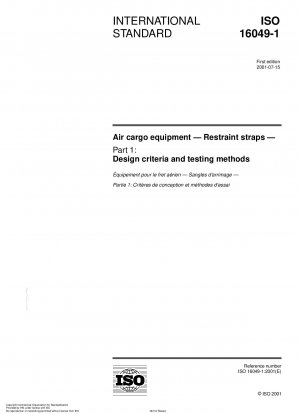ISO 16049-1:2001
Air cargo equipment - Restraint straps - Part 1: Design criteria and testing methods
- Standard No.
- ISO 16049-1:2001
- Release Date
- 2001
- Published By
- International Organization for Standardization (ISO)
- Status
- Replace By
- ISO 16049-1:2013
- Latest
- ISO 16049-1:2020
- Scope
- 1 This part of ISO 16049 specifies the design criteria and testing methods applicable to air cargo restraint straps to be used for tie-down of unitized or non-unitized cargo on board civil transport aircraft. It aims at identifying the design criteria and testing methods adequate to guarantee the ultimate load and operational dependability of cargo restraint strap assemblies with a typical 22 250 N (5 000 Ibf) rated ultimate tension load capability, as used by the airline industry in order to restrain, on board civil transport aircraft during flight: — cargo loaded and tied down on to airworthiness certified air cargo pallets, themselves restrained into aircraft lower deck or main deck cargo systems meeting the requirements of ISO 8097 (NAS 3610), or — non-unitized individual pieces of cargo, or pieces of cargo placed on to an unrestrained ("floating") pallet into either lower deck or main deck containerized cargo compartments of an aircraft. 2 The same restraint strap assemblies can also be used in other applications such as: — non-containerized (bulk loaded) baggage and cargo compartments, — to ensure cargo restraint inside an airworthiness certified air cargo container. NOTE The ultimate loads permissible on the attachment points available in most aircraft bulk compartments and inside most air cargo containers are significantly lower than 22 250 N (5 000 Ibf). This results in the restraint arrangements ultimate load capability being dictated by the weakest element, i.e. the attachment points. Typical 22 250 N ultimate load restraint straps will therefore be in excess of the requirements for such applications. 3 This part of ISO 16049 describes the design criteria for individual restraint strap assemblies, but does not intend specifying in any manner the way they are to be used aboard aircraft to ensure proper restraint throughout the certified flight envelope. It is important that tie-down arrangements meet all the applicable requirements of the Airworthiness Authorities approved Weight and Balance Manual for the aircraft type or sub-type concerned, particularly as regards, but not necessarily limited to, ultimate load factors to be taken into account to determine the number of straps to be used in each direction of restraint, maximum angles to be observed with the direction of restraint, minimum spacing of attachment points, etc. 4 When restraint strap assemblies are attached to the edge rails of a certified air cargo pallet meeting the requirements of ISO 8097, operating instructions should duly take into account the restraint net attachment point locations on the pallet edge rail and other requirements defined by the appropriate ISO 8097 configuration drawing(s). 5 The use of reliable and guaranteed restraint strap assemblies does not alone ensure flight safety: it also requires straps to be used and tie-down to be performed in accordance with operating instructions established by the aircraft manufacturer, by competent, suitably trained, personnel as defined in 4.18 of ISO 9002:1994. 6 Subject to proper operating instructions in accordance with 1.3 and 1.4, using unit restraint strap assemblies manufactured to an adequate design and a tested ultimate load capability is nevertheless deemed necessary in order to ensure flight safety. Although restraint straps are not formally subject to airworthiness certification, they serve an equivalent purpose and must be designed, fabricated, tested and used with equivalent precautions: this part of ISO 16049 is intended to allow manufacturer's self-certification under an approved ISO 9000 series, or equivalent, quality control programme.
ISO 16049-1:2001 Referenced Document
- ISO 12118:1995 Air cargo equipment - Identification of double-stud tie-down fittings having an omnidirectional rated load capacity of 22250 N (5000 lbf) or above
- ISO 16049-2 Air cargo equipment — Restraint straps — Part 2: Utilization requirements and recommendations and lashing calculations*, 2020-01-10 Update
- ISO 1833:1977 Textiles; Binary fibre mixtures; Quantitative chemical analysis
- ISO 2076:1999 Textiles - Man-made fibres - Generic names
- ISO 4117:1993 Air and air/land cargo pallets; specification and testing
- ISO 4171:1993 Air cargo equipment; interline pallets
- ISO 7166:1985 Aircraft; Rail and stud configuration for passenger equipment and cargo restraint
- ISO 8097 Aircraft - Minimum airworthiness requirements and test conditions for certified air cargo unit load devices*, 2001-08-01 Update
- ISO 9788:1990 Air cargo equipment; cast components of double stud fitting assembly with a load capacity of 22250 N (5000 lbf), for aircraft cargo restraint
- ISO/TR 8647:1990 Environmental degradation of textiles used in air cargo restraint equipment
ISO 16049-1:2001 history
- 2020 ISO 16049-1:2020 Air cargo equipment — Restraint straps — Part 1: Design criteria and testing methods
- 2013 ISO 16049-1:2013 Air cargo equipment - Restraint straps - Part 1: Design criteria and testing methods
- 2001 ISO 16049-1:2001 Air cargo equipment - Restraint straps - Part 1: Design criteria and testing methods
